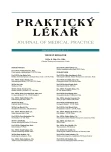Osteopenia – a potential complication of phenylketonuria
Authors:
I. Žofková 1; M. Bayer 2
Authors‘ workplace:
Endokrinologický ústav Praha
Ředitelka: RNDr. Běla Bendlová, CSc.
1; Dětská klinika LF a FN, Hradec Králové
Přednosta: prof. MUDr. Milan Bayer, CSc.
2
Published in:
Prakt. Lék. 2011; 91(8): 482-484
Category:
Of different specialties
Overview
Phenylketonuria is a consequence of altered phenylalanine degradation to 5-hydroxytryptofan, caused by mutations in the phenylalanine hydroxylase gene. Increased phenylalanine levels in blood and tissues are toxic to the brain and certain systems. Although the dominant feature of untreated phenylketonuria is progressive intellectual impairment, in a number of children and adolescents inadequate development of bone also occurs.
The fundamental pathogenic mechanism of bone damage is most probably due to the direct negative effect of phenylalanine on bone metabolism. Exclusion of phenylalanine from the diet protects the brain and, in some way, also the skeleton from phenylalanine’s toxic effects. On the other hand, in the absence of a supply of essential amino acids and osteoprotective molecules, bone development slows down. The possible osteotropic effect of a serotonin imbalance, induced by an interaction between the two different genes, is discussed.
Modern trends in treatment use tetrahydrobiopterin or phenylalanine-ammonia-lyase substitution, gene therapy and/or transplantation of liver cells.
Key words:
phenylketonuria, phenylalanine, 5-OH tryptophan, phenylalanine hydroxylase, PAH gen, tetrahydrobiopterin, serotonin.
Sources
1. Adamczyk, P., Morawiec-Knysak, A., Pludowski, P. et al. Bone metabolism and the muscle-bone relationship in children, adolescents and young adults with phenylketonuria. J. Bone Miner. Metab. 2011, 29(2), p. 236-244.
2. Ambroszkiewicz, J., Gajewska, J., Laskowska-Klita, T. Markers of bone formation and resorption in prepubertal children with phenylketonuria. Med. Wieku Rozwoj 2003, 7, p. 89-95.
3. Ambroszkiewicz, J., Gajewska, J., Chelchowska, M. et al. Concentration of osteoprotegerin, bone formation and resorption markers in patients with phenylketonuria. Pol. Merkur Lekarski 2008, 25, p. 57-60.
4. Ambroszkiewicz, J., Gajewska, J., Laskowska-Klita, T. A study of bone turnover markers in prepubertal children with phenylketonuria. Eur. J. Pediatr. 2004, 163, p. 177-178.
5. Bab, I., Yirmia, R. Depression, selective serotonin reuptake inhibitors, and osteoporosis. Curr. Osteoporosis Rep. 2010, 8, p. 185-191.
6. Blau, N., van Spronsen, F.J., Levy, H.L. Phenylketonuria. Lancet 2010, 376, p. 1417-1427.
7. Bliziotes, M. Update in serotonin and bone. J. Clin. Endocrinol. Metab. 2010, 95, p. 4124-4132.
8. Ducy, P., Karsenty, G. The two faces of serotonin in bone biology. J. Cell. Biol. 2010, 191, p. 7-13.
9. Feillet, F., Agostoni, C. Nutritional issues in treating phenylketonuria. J. Inherit. Metab. Dis. 2010, 33, p. 659-664.
10. Fernández Espuelas, C., Mantón Llorente, G., González López, J.M. et al. Bone mineral turnover and bone densitometry in patients with a high-risk diet: hyperphenylalaninemia and galactosemia. An. Pediatr. (Barc.) 2005, 63, p. 224-229.
11. Haney, E.M., Warden, S.J., Bliziotes, M.M. Effects of selective serotonin reuptake inhibitors on bone health in adults: time for recommendations about screening, prevention and management? Bone 2010, 46, p. 13-17.
12. Kawai, M., Rosen, C.J. Minireview: A skeleton in serotonin’s closet? Endocrinology 2010, 151, p. 4103-4108.
13. Lage, S., Bueno, M., Andrade, F. et al. Fatty acid profile in patiens with phenylketonuria and its relationship with bone mineral density. J. Inherit. Metab. Dis. 2010, Sept. 10 (Epub ahead of print).
14. Millet, P., Vilaseca, M.A, Valis, C., et al. Is deoxypyridinoline a good resorption marker to detect osteopenia in phenylketonuria? Clin. Biochem. 2005, 38, p. 1127-1132.
15. Modan-Moses, D., Vered, I., Schwarz, G. et al. Peak bone mass in patients with phenylketonuria. J. Inherit. Metab. Dis. 2007, 30, p. 202-208.
16. Pascucci, T., Andolina, D., Mela, I.L. et al. 5-Hydroxytryptophan rescues serotonin response to stress in prefrontal cortex of hyperphenylalaninaemic mice. Int. J. Neuropsychopharmacol. 2009, 12, p. 1067-1079.
17. Pitt, J.J. Newborn screening. Clin. Biochem. Rev. 2010, 31, p. 57-68.
18. Porta, F., Spada, M., Lala, R., Mussa, A. Phalangeal quantitative ultrasound in children with phenylketonuria: a pilot study. Ultrasound Med. Biol. 2008, 34, p. 1049-1052.
19. Schwahn, B., Mokov, E., Scheidhauer, K. et al. Decreased trabecular bone mineral density in patients with phenylketonuria measured by peripheral quantitative computed tomography. Acta Pediatr. 1998, 87, p. 61-63.
20. Sitta, A., Vanzin, C.S., Biancini, G.B. et al. Evidence that L:-carnitine and selenium supplementation reduces oxidative stress in phenylketonuric patients. Cell. Mol. Neurobiol. 2010, Dec 30 (Epub ahead of print).
21. van Spronsen, F.J., Enns, G.M. Future treatment strategies in phenylketonuria. Mol. Genet. Metab. 2010, 99, Suppl. 1: S90-95.
22. Verdel, B.M., Souverein, P.C., Egberts, T.C. et al. Use of antidepresant drugs and risk of osteoporotic and non-osteoporotic fractures. Bone 2010, 47, p. 604-609.
23. Vestergaard, P. Fracture risk of antidepresants. Expert Rev. Neurother. 2009, 9, p. 137-141.
23. Webster, D., Wildgoose, J. Tyrosine supplementation for phenylketonuria. Cochrane Database Syst. Rev. 2010, 8, CD001507.
24. Yadav, V.K., Ryu, J.H., Suda, N. et al. Lrp5 controls bone formation by inhibiting serotonin synthesis in the duodenum. Cell 2008, 135, p. 825-837.
25. Yannicelli, S., Medeiros, D.M. Elevated plasma phenylalanine concentrations may adversely affect bone status of phenylketonuric mice. J. Inherit. Metab. Dis. 2002, 25, p. 347-361.
26. Zeman, J., Bayer, M., Stepan, J. Bone mineral density in patients with phenylketonuria. Acta Pediatr. 1999, 88, p. 1348-1351.
Labels
General practitioner for children and adolescents General practitioner for adultsArticle was published in
General Practitioner

2011 Issue 8
- Metamizole at a Glance and in Practice – Effective Non-Opioid Analgesic for All Ages
- Memantine in Dementia Therapy – Current Findings and Possible Future Applications
- Advances in the Treatment of Myasthenia Gravis on the Horizon
- Possibilities of Using Metamizole in the Treatment of Acute Primary Headaches
- Hope Awakens with Early Diagnosis of Parkinson's Disease Based on Skin Odor
Most read in this issue
- Advances in operative treatment of fractures of upper and lower extremities
- Short intervention and first aid for patients with addictive diseases
- Study of four POCT systems for HbA1c measurement
- Problematic of doping in general practice
